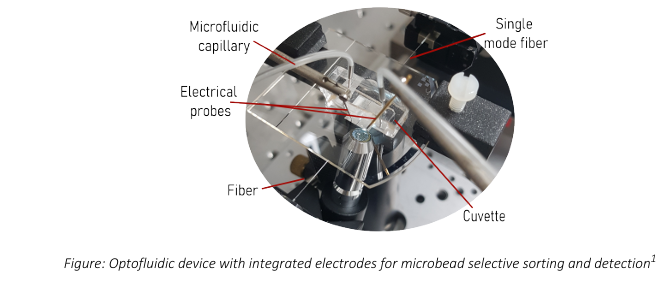Towards a universal optoelectrical microsensor: Microdevice for viscosity monitoring in liquid media
Published : 28 October 2024
 Towards a universal optoelectrical microsensor: Microdevice
Towards a universal optoelectrical microsensor: Microdevice
for viscosity monitoring in liquid media.
Key words:
Integrated photonics, sensors, device characterization.
Location:
CROMA Lab (UMR 5130).
Supervisors:
Elise Ghibaudo, Olivier Lavastre (CROMA) and Leticia Gimeno Monge (G2Elab).
Period and length:
Spring 2025, 6 months.
Contact:
Elise Ghibaudo, Olivier Lavastre (CROMA) and Leticia Gimeno Monge (G2Elab).
Additional information:
http://croma.grenoble-inp.fr/
Context:
Viscosity may be an indicator for either purity or pollutant presence in a liquid. For example, a reactive polymer can partially reticulate in presence of certain ions or molecules, thus changing the viscosity of the liquid media acting as a solvent. Common viscosity measurement solutions require sizable sample volumes (1 to 500 g) and durations (1 to 2h per analysis). Any solution that could speed up measurements and/or decrease the chemical sample volumes is extremely interesting.
CROMA expertise contributing to this project is twofold:
- Development of an integrated photonics device on glass1 (thus plastic free) for studying microbead behaviour (1 to 10 µm) in liquid media as well as associated quantifying and image processing techniques for microbead tracking.
- Development of a contactless analysis device2 (optical tweezer) GE2LAB brings to the project the expertise in microsensors including microfluidic and dielectrophoretic (DEP)3,4 function

Internship objectives:
In this project we aim at developing a brand-new generation of microdevices able to track viscosity evolution in real-time (Stop and Flow method) in a liquid environment. The working principle relies on correlating microbead movement, induced by DEP forces, to viscosity: the more viscous the fluid, the slower the microbead movement.
Internship topic :
Proof of concept validation opens the way for a universal optoelectrical sensor technology with numerous future applications, particularly in the field of sensors for healthcare, agri-food, security and environment industries. The change between application domains will come from the choice of an appropriate reactive polymer/targeted molecules or ions pair, likely to induce a measurable viscosity
variation.
Work and collaborative environment:
The recruited candidate will be trained in the different project aspects in order to complete the work:
- Bibliography on viscosity sensors and integrated photonics sensors physical principles
- Learning how to handle the sensor prototype for microbead selective sorting and detection, particularly for performing optical measurements
- Prototype adaptation for viscosity measurements: specs definition for measurable fluid types and viscosity ranges
- Setup of a Stop and Flow microfluidic measurement method adapted to the existing device
- Viscosity measurements with the existing device and the adapted protocol
Depending on the project progress and the candidate motivations, the orientation given to the internship final leg of the work may vary: valorisation of the obtained results, design of a new prototype optimizing one or more functions (microfluidic, electrical, optical).
The recruited candidate work will take place at CROMA and will have access to existing characterization and prototyping resources in the laboratory. The internship will be supervised by three researchers from CROMA and G2Elab who wish to join their expertise in multimodal sensing, microsystems and integrated photonics in the interest of developing this original viscosity.measurement method.
Profile requirements:
This internship subject is aimed at students at a Master 2 Research or last year engineering school level. The subject is adapted to training programs with a strong focus on micro nanotechnologies, photonics, biosensors, applied physics… The internship main content and objectives may be discussed and slightly adapted to match the candidate motivations as best as possible.
Applications :
To submit your application, please send an email (see contacts above) including a motivation letter, your CV, a copy of your grades and diplomas.
1 – M. Gardies, D. Bucci, & E. Ghibaudo, Sorting and sensing of dielectric microparticles by a multiphysics approach: integrated electro-opto-fluidic function for environmental application. In Integrated Optics: Devices, Materials, and Technologies XXVII, (2023). Vol. 12424, pp. 164-175. SPIE.
2 – C.-C. Chiang, M.-T. Wei, Y.-Q. Chen, P.-W. Yen, Y.-C. Huang, J.-Y. Chen, O. Lavastre, H. Guillaume, Optical tweezers based active microrheology of sodium polystyrene sulfonate NaPSS. Opt. Express 2011, 19(9):8847 8854.
3 – GIMENO L., TALBI A., VIARD R., MERLEN A., PERNOD P., PREOBRAZHENSKY V., “Synthetic jets based on micro magneto mechanical systems for aerodynamic flow control”, J. Micromech. Microeng., 20 075004, (2010), doi: 10.1088/0960-1317/20/7/075004
4 – GIMENO L., RAULY D., MARTINS J.M.F., NEHME H., XAVIER P., CHAMBEROD E., “AC dielectrophoresis of bacteria in coaxial mesoscopic structure potentially applicable for rapid detection and easy characterization at low cost”, BioEM 21, 26-30/9/2021 Ghent, Belgium, (2021)



 Contact us
Contact us How to find us
How to find us









